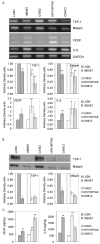Human papillomavirus causes an angiogenic switch in keratinocytes which is sufficient to alter endothelial cell behavior
- PMID: 17602722
- PMCID: PMC2043482
- DOI: 10.1016/j.virol.2007.05.030
Human papillomavirus causes an angiogenic switch in keratinocytes which is sufficient to alter endothelial cell behavior
Abstract
One of the requirements for tumor growth is the ability to recruit a blood supply, a process known as angiogenesis. Angiogenesis begins early in the progression of cervical disease from mild to severe dysplasia and on to invasive cancer. We have previously reported that expression of human papillomavirus type 16 E6 and E7 (HPV16 E6E7) proteins in primary foreskin keratinocytes (HFKs) decreases expression of two inhibitors and increases expression of two angiogenic inducers [Toussaint-Smith, E., Donner, D.B., Roman, A., 2004. Expression of human papillomavirus type 16 E6 and E7 oncoproteins in primary foreskin keratinocytes is sufficient to alter the expression of angiogenic factors. Oncogene 23, 2988-2995]. Here we report that HPV-induced early changes in the keratinocyte phenotype are sufficient to alter endothelial cell behavior both in vitro and in vivo. Conditioned media from HPV16 E6E7 expressing HFKs as well as from human cervical keratinocytes containing the intact HPV16 were able to stimulate proliferation and migration of human microvascular endothelial cells. In addition, introduction of the conditioned media into immunocompetent mice using a Matrigel plug model resulted in a clear angiogenic response. These novel data support the hypothesis that HPV proteins contribute not only to the uncontrolled keratinocyte growth seen following HPV infection but also to the angiogenic response needed for tumor formation.
Figures



Similar articles
-
Expression of human papillomavirus type 16 E7 is sufficient to significantly increase expression of angiogenic factors but is not sufficient to induce endothelial cell migration.Virology. 2011 Feb 20;410(2):283-90. doi: 10.1016/j.virol.2010.11.010. Epub 2010 Dec 14. Virology. 2011. PMID: 21159359 Free PMC article.
-
Cytoplasmic poly(A) binding proteins regulate telomerase activity and cell growth in human papillomavirus type 16 E6-expressing keratinocytes.J Virol. 2010 Dec;84(24):12934-44. doi: 10.1128/JVI.01377-10. Epub 2010 Oct 13. J Virol. 2010. PMID: 20943973 Free PMC article.
-
Modulation of microRNA-mRNA Target Pairs by Human Papillomavirus 16 Oncoproteins.mBio. 2017 Jan 3;8(1):e02170-16. doi: 10.1128/mBio.02170-16. mBio. 2017. PMID: 28049151 Free PMC article.
-
Expression of human papillomavirus type 16 E6 and E7 oncoproteins in primary foreskin keratinocytes is sufficient to alter the expression of angiogenic factors.Oncogene. 2004 Apr 15;23(17):2988-95. doi: 10.1038/sj.onc.1207442. Oncogene. 2004. PMID: 14968115
-
MicroRNA 203 expression in keratinocytes is dependent on regulation of p53 levels by E6.J Virol. 2010 Oct;84(20):10644-52. doi: 10.1128/JVI.00703-10. Epub 2010 Aug 11. J Virol. 2010. PMID: 20702634 Free PMC article.
Cited by
-
Gut microbiota, an emergent target to shape the efficiency of cancer therapy.Explor Target Antitumor Ther. 2023;4(2):240-265. doi: 10.37349/etat.2023.00132. Epub 2023 Apr 26. Explor Target Antitumor Ther. 2023. PMID: 37205307 Free PMC article. Review.
-
Human Papillomavirus and the Stroma: Bidirectional Crosstalk during the Virus Life Cycle and Carcinogenesis.Viruses. 2017 Aug 9;9(8):219. doi: 10.3390/v9080219. Viruses. 2017. PMID: 28792475 Free PMC article. Review.
-
Hypoxia-specific stabilization of HIF-1alpha by human papillomaviruses.Virology. 2009 May 10;387(2):442-8. doi: 10.1016/j.virol.2009.02.036. Epub 2009 Mar 24. Virology. 2009. PMID: 19321184 Free PMC article.
-
Expression of human papillomavirus type 16 E7 is sufficient to significantly increase expression of angiogenic factors but is not sufficient to induce endothelial cell migration.Virology. 2011 Feb 20;410(2):283-90. doi: 10.1016/j.virol.2010.11.010. Epub 2010 Dec 14. Virology. 2011. PMID: 21159359 Free PMC article.
-
Persistence of human papillomavirus infection: keys to malignant progression.Trends Microbiol. 2011 Jan;19(1):33-9. doi: 10.1016/j.tim.2010.10.002. Epub 2010 Nov 1. Trends Microbiol. 2011. PMID: 21050765 Free PMC article. Review.
References
-
- Arbeit JM, Olson DC, Hanahan D. Upregulation of fibroblast growth factors and their receptors during multi-stage epidermal carcinogenesis in K14-HPV16 transgenic mice. Oncogene. 1996;13:1847–1857. - PubMed
-
- Bequet-Romero M, Lopez-Ocejo O. Angiogenesis modulators expression in culture cell lines positives for HPV-16 oncoproteins. Biochem.Biophys.Res.Commun. 2000;277:55–61. - PubMed
Publication types
MeSH terms
Substances
Grants and funding
LinkOut - more resources
Full Text Sources

